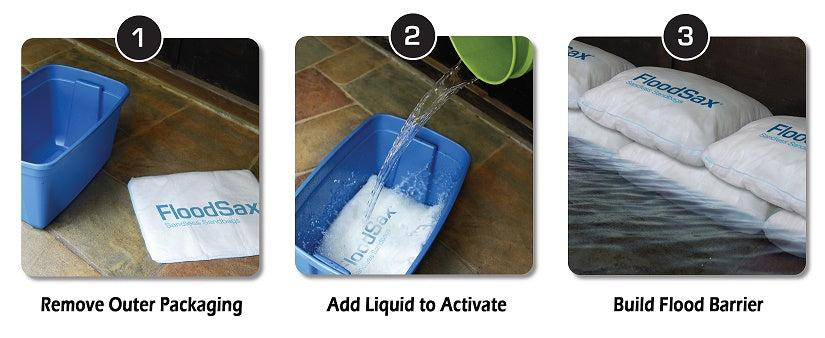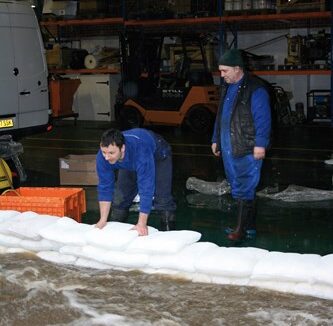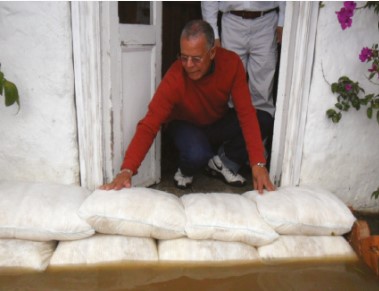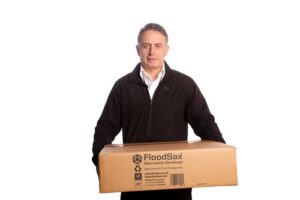Average USA insurance payout from flooding is $25,000- $75,000. This will be higher for Cayman given most products have to be imported (new kitchen cabinets, furniture, building materials etc) carrying a large duty and shipping fees.
But you can prevent this with FloodSax® alternative sandbags. World-leading anti-flood product FloodSax® are a multi-purpose alternative to traditional sandbags and are way easier to store, transport and deploy.
Did you know..Floodsax cost $1.80 more than a sandbag. If you go to your local hardware store the charge for a prefilled sandbag is $15. Floodsax per bag costs $16.80
Just like sandbags, FloodSax® can be built into barriers to keep flood water out of homes and businesses.
Everyone is responsible for protecting their home or business from flooding and multi-purpose FloodSax® alternative sandbags are an affordable and very effective way to do this.
Flooding wrecks the very fabric of your home – walls will need replastering and floors relaying – as well as destroying your possessions. Any electrical items such as TVs, dishwashers and tumble dryers will need to be thrown away if they are damaged by floodwater.
How FloodSax® work and how to build FloodSax into flood-resistant barriers
FloodSax® can quickly be built into barriers to protect doors – be that your front door, patio door, garage door or warehouse door – from flooding.
FloodSax® are vacuum-packed in packs of five in easy to carry bags and four packs fit into one cardboard box weighing just 21lbs (9.5kilos)– that’s the equivalent to 20 traditional sandbags and imagine trying to lift and shift them to both store and then putting them in place when a flood is about to happen.
To deploy FloodSax® as alternative sandbags when a flood is forecast or is actually happening, simply immerse the FloodSax® in 20 litres of water in a large bucket or tub. You could even use a hosepipe or, if time is really critical, use the floodwater itself.

The FloodSax® will then expand in around five minutes to weigh 20kg (44lbs). If you use warm water the FloodSax® will expand even quicker in around 3 minutes. A special gelling polymer inside simply absorbs the water and then keeps it in the FloodSax® so it can be used for however long the emergency lasts, which could be several months.
Each row of FloodSax® will keep out approximately 6 inches of water and usually two or three rows are enough to keep floodwater out. Just lay the FloodSax® next to one another and then the row on top across the joins below to make it a firm barrier. FloodSax® are so heavy and tough, water blasted at them through a firefighting hose won’t shift them.




During torrential rain a row 2 layers high of FloodSax® kept a severe flood out of a company’s warehouse. The business had previously been flooded in the warehouse which had led to a $354,000 insurance claim and when the FloodSax® kept the floodwater at bay there was high technology electrical equipment valued at more than $500,000 in the warehouse. The FloodSax® stopped any water from getting in and damaging the equipment.
FloodSax® factfile including sizes and weights
Each FloodSax® is made up of 4 layers with 12 internal absorbent sections creating a multi-chamber system to keep the water fully absorbed. These absorbent chambers are then sewn together into an outer sleeve of a nonwoven material.
Each FloodSax® weighs just under 1lb (0.39 kilos) before it comes into contact with water and is 20” (52cm) x 18.5” (47cm) x 0.5” (1.2cm) in size. After it has absorbed the water it will be about 8” (20cms) deep.
A box of 20 FloodSax® weighs just 21lbs (9.5kilos) and is 21.5” (55cms) x 21” (54cms) x 6” (15cms) so can easily be carried by one person. They would struggle to carry just one old fashioned sandbag.

Disposing of FloodSax®
FloodSax® alternative sandbags can be reused and we describe how this can be done on how to use floodsax click link . That said if sewage water or contaminants (floodwater that contains chemicals such as fuel from cars or oil) have come into contact with the floodsax then it should be disposed of once they have been used to stop flooding … and the same goes for traditional sandbags.

